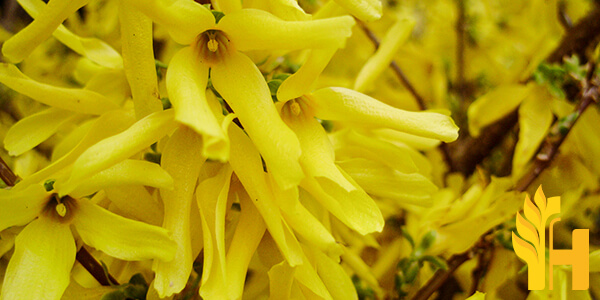Forsythia price

Where to buy and sell Forsythia, lowest (cheapest) and highest price.
check offers buy sell ForsythiaToday price for ForsythiaForsythia wholesale prices 2022
The Current commodity price of Forsythia per kg, pound in the world in the global markets
Forsythia shrub
Forsythia is a shrub that can reach up to 8 feet in height. It has got green stems that with time turn woody and produce rough greyish brown bark. For most of the year, the shrub is covered with dense green and bright green leaves but is the most recognizable in spring when it creates an abundance of yellow flowers. Forsythia flowers are bell-shaped, have four petals, and occur densely on the stems.It is a fast-growing plant that naturally arches over, but there are many more cultivars that may differ and be more rigid or splayed. It requires regular pruning as it tends to become too scraggly and too leggy. They make an ideal plant to form gedges. After blooming season, the shrub is densely covered with leaves which ensure sound screen and make great privacy. The shrubs require low maintenance. They grow best in full sun areas or partially shaded ones in well-drained soil. They may require watering in extended dry periods.
They make a perfect addition to every garden and landscape as they start blooming quite early in spring. They are often referred to as the garden’s wake-up alarm. They are also great to create a natural fence in a type of stellar hedge. Its fruit is used for medicine. It is used especially for various cases of swelling, tonsillitis, sore throat, vomiting, heart disease, gonorrhea and to treat skin rash as well as feel.
The plant is known all over the world and cultivated in many places for its ornamental and medicinal purposes. It is considered one of the 50 fundamental herbs in Chinese herbology. In some places, it is known under the common name „Easter tree” as it usually blooms at the time of this holiday. The shrub was introduced in the United States in the early twentieth century. Nowadays forsythia is known in many different species, most of which are native to China and Korea. Two of the species are commonly cultivated for their ornamental purposes - Forsythia × intermedia and Forsythia suspensa. They are both spring-flowering shrubs characterized by their intensive flowering and bright, vibrant yellow flowers.
Global forsythia production
Forsythia flowers are produced in many parts of the world, with China being the leading producer. Other major producers include Japan, South Korea, and the United States. Forsythia flowers are also grown in Europe, Australia, and New Zealand. The forsythia flower is a popular choice for floral arrangements and is used in many traditional medicines. The forsythia flower has a long history of cultivation and has been used in Traditional Chinese Medicine for centuries. The forsythia flower is believed to have medicinal properties that can help treat a variety of ailments. Forsythia is also used in Feng Shui to bring good luck and fortune. The forsythia flower is a symbol of spring and new beginnings. The forsythia flower is often seen in bouquets and floral arrangements. The forsythia flower is also the birth flower for the month of April. Forsythia flowers are typically yellow in color, but can also be found in white and pink varieties. The forsythia flower is a member of the Oleaceae family and is related to the jasmine plant. The forsythia flower blooms in the spring and is often used as an early herald of the season. The forsythia flower is one of the first flowers to bloom in the spring and is a sign of hope and new beginnings. The forsythia flower is native to Asia and was introduced to Europe in the 18th century. The forsythia flower is named after William Forsyth, a Scottish botanist.Download our new
Husfarm App
Stay up to date with the current prieces of agricultural products all over the world.
Do you want to sell agricultural products?
Are you an Agricultural processor looking for high-quality products to buy?
Post an ad for FREE!
